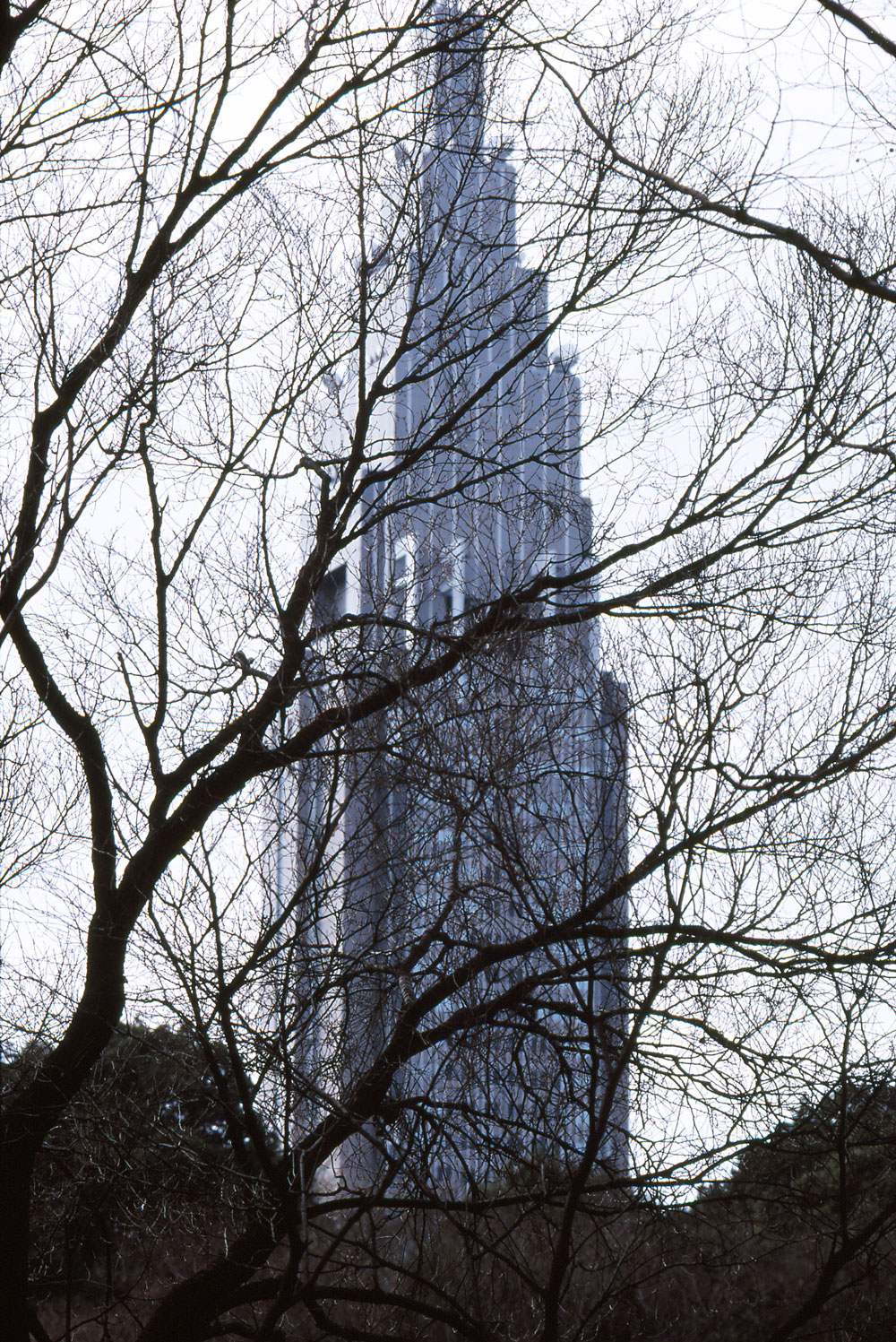NIKKOR - The Thousand and One Nights No.32

Ai AF DC Nikkor 135mm F2S
Tonight, I would like to talk about the high-speed medium telephoto lenses as a follow-up to Tale Thirty. I will discuss how the high-speed medium telephoto lenses have changed as the automatic focusing (AF) system has been put into practical application.
by Kouichi Ohshita
I. AF 85mm f/1.8

High-speed medium telephoto lenses lost out in the end due to the widespread proliferation of AF system lenses. The adoption of the AF system requires a motor drive to move the lens system for focusing. For this purpose, it is essential to reduce the weight of the lens elements. Ultra-telephoto lenses, synonymous with heavyweight lenses, had been redesigned earlier so as to operate with the IF system, which allows focusing simply by moving a part of the lens elements. In addition, telephoto zoom lenses were typically designed to achieve focusing with the front group of the lens elements.
The weight of the moving lens elements was far smaller compared to the high-speed medium telephoto lenses. For this reason, both types of lens systems could evolve relatively smoothly to adopt the AF design. In contrast to this, the high-speed medium telephoto lenses are designed for focusing by moving the entire lens system. Thus, a good solution could not be easily thought of to smoothly move the high-speed medium telephoto lens system, composed of a massive block of elements, at a fast speed and with great accuracy. The restrictions were also a problem for to competitors who were similarly struggling to implement the AF lenses, and it was a difficult challenge for lens designers to find a way to focus a large-diameter lens automatically.
This was the situation when the AF Nikkor 85mm f/1.8S made its market debut (released in 1988). This system looks like an ordinary Gaussian lens at first glance as shown in Figure 1, though it was in fact a "new Gaussian lens" allowing focusing simply by moving the rear group of the 3-elements. The 80mm f/2.8 for f/3 AF discussed in Tale Twenty Three was also designed to move only the rear group of elements of the Gauss type for focusing. However, the two front elements in the rear group and the last element had to be moved at different speeds, and thus the complicated mechanism was left as a challenge to be solved in the future. The AF 85mm f/1.8 took on the challenge and was able to achieve the brightness of f/1.8. The AF 85mm f/1.8 was thus just like a savior for the development of the AF high-speed medium telephoto lens.
II. DC concept (Defocus-image Control)
The designer of this AF 85mm f/1.8 was one of my direct seniors. He was first engaged in the quality assurance of lenses, and he had gained a profound knowledge about the evaluation of lenses and enjoyed photography as a hobby when he was not working. I learned a lot from him about focal length, aberration measurement and other various tips for photo taking. He had a sense of humor and art.
For example, he made up a collage of pictures just like the currently popular photo stickers from souvenir photographs taken during the employees' trip by adding balloons to photo prints and using cut-and-paste editing with scissors. Coworkers were all impressed with the finished quality. In those days, film cameras were in their glory while image processing was not popular. As a budding lens designer, I was first awakened to the ways of enjoying photographs.
It was therefore natural that the senior colleague began studying defocusing through the development of high-speed medium telephoto lenses.
What kind of out-of-focus images look beautiful? How must the optical system perform to realize the beautiful effects of defocusing? A close correspondence between defocusing characteristics and spherical aberration had been revealed based on a variety of past studies. When spherical aberration is left a bit undercorrected, flares surround the out-of-focus background, thereby resulting in a close-to-ideal out-of-focus background.
In practice, however, this approach offers two problems. First, undercorrected spherical aberration can cause a ring or off-axis aberration in the out-of-focus foreground. This means that defocusing cannot be attained simultaneously for both foreground and background. The second problem is deterioration in lens performance. This suggests that any residual spherical aberration is more likely to spoil the sharpness compared to zero spherical aberration.
Well then, can we implement such a lens that allows varying the defocusing characteristics by changing the aberrations a little bit? This approach would be able to realize the ideal lens accepted by all of those who demand sharpness or want to utilize the out-of-focus foreground, and for those who call for a soft out-of-focus background. He carefully examined the data on the Gaussian lenses to find a method for changing the shape of spherical aberration alone without increasing the other aberrations. Finally, he found the solution: the challenge can be solved by changing the distances between the lens elements in the front group of Gaussian lens.
A combination of two innovations, the rear-focusing design established in the development of AF 85mm f/1.8 and the Defocus-image Control (DC), helped create the AF DC Nikkor 135mm f/2S, the first AF 135mm f/2 lens, in 1991.
III. Lens configuration

This lens system is a modified Gaussian lens configured with 7 elements in 6 groups as shown in Figure 2. However, the entire configuration is longer compared to the lens configuration of AF 85mm f/1.8 shown in Figure 1. Especially, it features a large air layer between the front lens elements and the following elements, and the front lens elements have the cemented configuration. The Gaussian lenses were originally designed to offer superior compensation for chromatic aberration, and this lens provides additionally improved longitudinal Chromatic Aberration due to the configuration of the cemented front lens elements.
"How's that for this lens? It's beautiful, isn't it? The cemented lenses are very effective."
My superior gave me a description of the lens while showing the cross-sectional view of the lens. The optical system designers at Nikon place a premium on the visual beauty of a lens cross-sectional view. This demonstrates that they have a perception about lenses that those optical systems can offer better-corrected aberrations and are robust enough to be resistant to any manufacturing errors, when lens elements are arranged in a reasonable configuration and light rays smoothly pass through the individual faces of the lens elements. They had also pursued the beauty of lens configuration, not only the defocusing characteristics.
For focusing, this lens is designed to use only the rear group of three Gaussian elements, the same as the AF 85mm f/1.8. As a result, the lens weight is reduced to a quarter or less compared to when the entire lens system is moved, thus allowing fast-speed focusing.
This lens is also capable of controlling the foreground and background defocusing by varying the distance between the cemented lens elements in the front group and the following convex and concave lenses without affecting astigmatism and chromatic aberration, changing the spherical aberration slightly. The spherical aberration is corrected to nearly zero when the DC ring is set at the center position. Consequently, aberration balance is close to the balance for ultra-telephoto lenses in which individual aberrations are corrected to the extreme limits. This is intended to ensure the highest possible performance when the DC is set not to work and to keep the foreground and background defocusing in the "gentle" conditions whenever possible. That constitutes the individuality of this lens system which distinguishes itself from the existing medium telephoto lenses, in which spherical aberration is left a bit undercorrected to provide a favorable out-of-focus background.

D70 AF 135mm at maximum aperture of f/2

D70 AF 135mm at maximum aperture of f/2
Background defocusing priority mode
(DC ring set to "R")
D70 AF 135mm at maximum aperture of f/2

D70 AF 135mm at maximum aperture of f/2
When the DC ring is turned to "R", spherical aberration becomes undercorrected to soften the edge of out-of-focus background. Conversely, when the DC ring is turned to "F," spherical aberration is overcorrected to additionally blur away the profile of the out-of-focus foreground.
It is easy to comment on the completed product as explained above, though there were invisible hardships in the process up to the completion of the lens. Repeated trials were required to reduce the weight of the moving rear group of lens elements to a required minimum for focusing, and also to minimize the traveling distance. As a result, the shortest distance was reduced to 1.1 m from 1.2 m in the first trial lens. In addition, based both on simulation and on the repeated taking of actual photographs, the best level of spherical aberration was determined for individual aperture steps, and the graduations were marked. It was the first attempt to vary the defocusing characteristics, and the best solution could not be found by a single trial manufacture.
It was necessary to repeatedly take lots of actual shots for many fine adjustments, and the DC graduations were marked up to f/5.6. The DC ring was designed to rotate beyond f/5.6, in fact, and that was because the graduations were supposed to be marked up to f/11 in the first place. In the end, marking of graduations was canceled since it limited the extent of defocusing and resulted in a lower degree of effectiveness by stopping down the lens. However, to enjoy the soft-focus effect available when the ring is rotated all the way, the stroke remained and was not removed. If you have one, try out the soft-focus effect by turning the DC ring all the way.
IV. Imaging capabilities of the lens

Nikon F5
Ai AF DC Nikkor 135mm f/2S f/2 Auto. TREBI100 (DC ring set at R2)
©2006/2007 Kouichi Ohshita

Nikon F5
Ai AF DC Nikkor 135mm f/2S f/5.6 Auto. TREBI100 (DC ring set at the center)
©2006/2007 Kouichi Ohshita

Nikon D50
AiAF DC Nikkor 135mm f/2S f/2 Auto. ISO200 (DC ring set at R2.8)
©2006/2007 Kouichi Ohshita
Let's examine the imaging characteristics of this lens based on sample photos.
Sample 1 shows a photo taken at full-open aperture, taking full advantage of the lens performance. The out-of-focus background looks smooth due to the DC ring set at R2. However, you would see ring and off-axis aberrations in some parts of the foreground. In actuality, foreground defocusing involves a larger extent compared to background defocusing and thus it may not become conspicuous in many cases.
Sample 2 shows a long-distance view taken by stopping down the lens to f/5.6 with the DC ring set at the center. Tree branches against a cloudy sky background are likely to become dull and unsharp when the photograph is taken with a flare-rich lens, though the sample photo provides a clear image of tree branches without blending them into the sky. The 135mm lens provides a slightly defocused building in the background due to the greater depth of field even by stopping down the lens to f/5.6, though the defocusing is gentle, as you can notice.
You are also recommended to use this lens with a digital camera. You can further enjoy the pleasure of handling the DC lens with the digital camera-specific benefit of being able to check the effects of DC on the spot immediately after taking every shot. Sample 3 shows a shot taken at full-open aperture with the lens mounted on the D50 and DC ring set at R2.8. Due to the excessive rotation of DC ring, flares can be seen on the focal points when viewed on the PC screen in a 100% scale (a factor of one), providing the soft-focus effect and causing the well-colored autumn leaves to appear soft.
The introduction of this lens was followed by the development of a series of high-speed medium telephoto lenses,
and the Ai AF DC Nikkor 105mm f/2D and Ai AF Nikkor 85mm f/1.4D were successively released in 1993 and 1995, respectively.
Finally, the currently available Nikon's range of medium telephoto lenses is to be brought to perfection. The successful development of a similar lineup as in the age of manual lenses owed much to the innovative rear-focusing design in AF 85mm f/1.8. This innovation was combined with a function for controlling the defocusing characteristics in the DC 135mm f/2 as the first attempt, which helped to successfully make the high-speed medium telephoto lens much more attractive. In the tale of Noct NIKKOR (Tale Sixteen), I explained the Noct as "the only NIKKOR lens that added values to the imaging characteristics" but this lens would take the concept even further, I'm sure.

NIKKOR - The Thousand and One Nights
The history of Nikon cameras is also that of NIKKOR lenses. This serial story features fascinating tales of lens design and manufacture.

